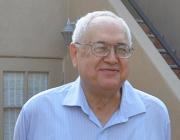Date Published:
MAR 8Abstract:
Molecular Dynamics simulations using a surface-hopping method for transitions between different electronic states are employed to study the dynamics following photoexcitation of the Ba(Ar)(125) cluster. The results are used to interpret spectroscopic experiments on large, size-distributed Ba(Ar)(n) clusters. The dynamics of the coupled electronic-nuclear motions in the cluster involves transitions between three potential energy surfaces, corresponding to the nearly-degenerate p-states of the excited Ba atom. Ejection of excited Ba atoms, adsorbed on the surface of the cluster, can take place. The focus in comparing theory and experiment is on the emission spectrum from the excited clusters, on the polarization of this radiation, and on the polarization of light emitted by excited Ba atoms ejected from the cluster. Based on the good agreement found between theory and experiment, a comprehensive picture of the excited state dynamics is given. It is found that upon excitation, energy is rapidly redistributed in the cluster and no direct ejection of Ba occurs. Electronic relaxation to the lowest P-state occurs, and the latter dominates the cluster emission spectrum and polarization. The electronic state relaxation is mostly complete within t less than or similar to 10 ps. Ejection of Ba atoms occurs as a rare and delayed event when a dynamical fluctuation creates a `'hot spot'' at the Ba site, with a non-adiabatic excitation to the highest electronic level. The results show the feasibility of near-quantitative understanding of non-adiabatic processes in large clusters. (C) 1996 American Institute of Physics.
